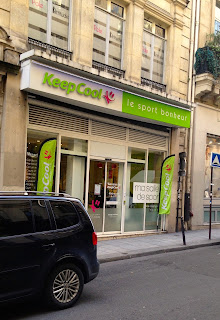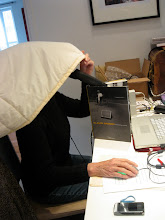Since those days, and for well over 100 years, it has been home to the bustling, busy trade of fabric manufacturers, fabric sellers, wholesale and retail dress shops.
In 1910, this emporium on the rue d'Aboukir, is holding a special sale ("soldes") of its silks, linens and other fabrics ("tissus").
And in the Passage Caire, the central hub of the district, these ladies are taking a break from their work sewing cuffs ("manchettes").
Today, though, the Passage Caire no longer hums with such activity. The Passage itself is huge, with many entrances from the various side streets, but strolling through this week, I found many store fronts shuttered.
There are still some dress shops, with racks of clothing ready to be shipped to retail outlets...
...there are a few mannequin shops, the figures of all sizes waiting for clothes for all ages...
...and the Beverly Cafe still seems to be in business in the central walkway. A sign on the window indicates that it is, as always, under the control of the "Loubavitch de France" -- a reminder that, in its early days, this was largely a Jewish neighborhood.
Out in the winding side streets, you can still see men carrying bolts of cloth from a fabric wholesaler, loading them onto rolling carts and wheeling them to the fashion houses.
Or trundling a rack of clothes to a retail shop.
But more and more, these "middle men" are finding the times and markets are changing. Many clothing manufacturers now buy their fabrics directly from China or India, no longer having a need for a broker in the Sentier.
In our own building, the venerable firm of T.C.R.M., who rented the third floor from the 1930s until last July (!) went out of business, replaced by the Films du Kiosque. Another "tissu" enterprise, formerly on the 1st floor, has been replaced by dermatologists!
I love to wander through the narrow, winding streets in the neighborhood, stopping to admire and be amazed at the variety of fabrics -- silks, lace, moiré, cottons -- in all colors from pastel to full on primary neon colors!
An open door to a retail shop ("vente au détail") as opposed to a wholesale shop ("vente en gros") is always a temptation!
Increasingly, though, this is what you notice: store front spaces for rent, businesses closed down. With the influx of dot-com companies and techie start-ups into the district, it's been interesting to watch the new retail store-fronts that are establishing themselves to serve the needs of this new Sentier population.
For example, my wonderful Keep Cool gym, on rue de Clery, used to be a fabric wholesaler. Then a fire destroyed the interior and all the contents. They never re-opened. Instead, it is now home to scores of attractive young people, with a few of us of a more mature age, all doing our best to keep fit as well as keep cool!
Further up the street, a hoverboard boutique just opened, full of eager customers for this popular form of transport.
The window display features a pop-art comic-book wonder!
Round the corner, Mister Phony will repair, unlock or recycle your iPhone, and sell you all the accessories you ever dreamed of.
Lower down on rue de Clery, a "tissu" shop is now a "Co-working Cafe". Here you can rent a desk for an hour (4,5 euros), or a day (20 euros), with a wi-fi fiber optique hook up, coffee, tea, hot chocolate, snacks, books and playlists.
Across the street, Mon Atelier en Ville, offers you space by the hour or day to work on your DIY project, whether you are designing a dress or building a bench.
And on the other side of rue Réaumur, the same idea welcomes architects and designers to work on their projects.
The biggest change, though, has to do with good food and excellent restaurants! On the Place Alexandre, the Hotel Edgar, a former convent, has about ten rooms, each lavishly decorated by different designers and stylists. It is also home to one of the best restaurants in the neighborhood.
Other eateries seem to be popping up every week, with a variety of ethnic menus.
Some of them a somewhat strange mix -- Bagel Sushi?!
Nowhere is the "foodie" world more present than on the tiny rue du Nil, where Greg Marchand began it all with his Bistro Frenchie.
Formerly a street full of "tissus" wholesalers, there now remains but one, this brave vendor of beautiful African fabrics.
As well as Bistro Frenchie, M. Marchand opened a casual bar across the street, and a few doors down, a fast food version, Frenchie To Go...
...and, new to us this year, Frenchie Caviste, with a good selection of wines.
A bakery opened on the corner last October, where yet another "rag trade" business used to be.
Add to this the "farm to shop" greengrocer and cheese shop that has been here for about three years, and the organic butcher and fishmonger across the street, and you really have no need to go anywhere else to eat like kings, or shop for super fresh "everything" for your home cooking!
It's supposed to snow in Paris this coming week, but we will miss it because India has beckoned -- we fly to Mumbai on Monday evening for a week, followed by a week of adventures in Rajasthan. Stay tuned for exotic blog posts when we return March 1st.
À bientôt!
Follow @JanetRobbins14
























































